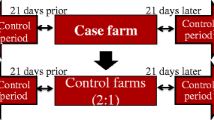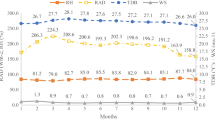Abstract
Climate change (CC) is expected to increase temperatures and the frequency of extreme weather events, which renewed interest in heat stress (HS) effects on dairy cattle farms. Resilience is a key concept that should be considered to better understand the dairy farms exposure to HS and to combat CC-related risks. Thus, this study aimed to investigate the aspects of HS vulnerability for Tunisian dairy cattle farming systems. Historical milk test-day records from official milk recording were merged with temperature and humidity data provided by public weather stations. Firstly, different models relying in two heat load indices were applied for HS exposure assessment. Secondly, broken line models were used to estimate HS thresholds, milk losses, and rates of decline of milk production associated with temperature-humidity index (THI) across parities. Thirdly, individual cow responses to HS estimated using random regression model were considered as key measures of dairy farming system sensitivity assessment to HS. Dairy farms are annually exposed for 5 months to high THI values above 72 in Tunisia. The tipping points, at which milk yield started to decline over parities with 3-day average THI, ranged between 65 and 67. The largest milk decline per unit of THI above threshold values was 0.135 ± 0.01 kg for multiparous cows. The milk losses estimated due to HS in the Holstein breed during the summer period (June to August) ranged between 110 and 142 kg/cow in north and south, respectively. A high HS sensitivity was proved especially in dairy farms characterized by large herd size and high milk production level. Hence, providing knowledge of dairy farms vulnerability to HS may provide the basis for developing strategies to reduce HS effects and plan for CC adaptation.




Similar content being viewed by others
References
Abid M, Schilling J, Scheffran J, Zulfiqar F (2016) Climate change vulnerability, adaptation and risk perceptions at farm level in Punjab. Pakistan Sci Total Environ 547:447–460
Aguilar I, Misztal I, Tsuruta S (2010) Genetic trends of milk yield under heat stress for US Holsteins. J Dairy Sci 93(4):1754–1758
Akyuz A, Boyaci S, Cayli A (2010) Determination of critical period for dairy cows using temperature humidity index. J Anim Vet Adv 9(13):1824–1827
Amamou H., 2020. Effects of climate change on dairy farming systems: evaluation and impacts of heat stress on dairy cow in Tunisia. Doctoral dissertation. Université de Liège, Belgique.
Amamou H, Beckers Y, Mahouachi M, Hammami H (2019) Thermotolerance indicators related to production and physiological responses to heat stress of holstein cows. J Therm Biol 82:90–98
Amamou H, Sassi M, Ben AH, Khemiri H, Mahouachi M, Beckers Y, Hammami H (2018) Climate change-related risks and adaptation strategies as perceived in dairy cattle farming systems in Tunisia. Clim Risk Manag 20:38–49
Mirkena T, Duguma G, Haile A, Tibbo M, Okeyo AM, Wurzinger M, Sölkner J (2010) Genetics of adaptation in domestic farm animals: a review. Livest Sci. https://doi.org/10.1016/j.livsci.2010.05.003
Ojango JM, Pollott G (2002) The relationship between Holstein bull breeding values for milk yield derived in both the UK and Kenya. Livest Prod Sci 74(1):1–12
Polsky L, von Keyserlingk MAG (2017) Invited review: effects of heat stress on dairy cattle welfare. J Dairy Sci 100(11):8645–8657
Ben Gara A, Rekik B, Bouallègue M (2006) Genetic parameters and evaluation of the Tunisian dairy cattle population for milk yield by Bayesian and BLUP analyses. Livest Sci 100:142–149. https://doi.org/10.1016/j.livprodsci.2005.08.012
Ben Salem M, Bouraoui R (2009) Heat Stress in Tunisia: effects on dairy cows and potential means of alleviating it. S Afr J Anim Sci 39:256–259. https://doi.org/10.4314/sajas.v39i1.61164
Bernabucci U (2019) Climate change: impact on livestock and how can we adapt. Anim Front Rev Mag Anim Agric 9:3. https://doi.org/10.1093/AF/VFY039
Bernabucci U, Basiricò L, Morera P, Dipasquale D, Vitali A, Piccioli CF, Calamari L (2015) Effect of summer season on milk protein fractions in Holstein cows. J Dairy Sci 98(3):1815–1827
Bernabucci U, Biffani S, Buggiotti L, Vitali A, Lacetera N, Nardone A (2014) The effects of heat stress in Italian Holstein dairy cattle. J Dairy Sci 97(1):471–486
Bohmanova J, Misztal I, Cole JB (2007) Temperature-humidity indices as indicators of milk production losses due to heat stress. J Dairy Sci 90(4):1947–1956
Bohmanova J, Misztal I, Tsuruta S, Norman HD, Lawlor TJ (2008) Short communication: genotype by environment interaction due to heat stress. J Dairy Sci 91(2):840–846
Ravagnolo O, Misztal I, Hoogenboom G (2000) Genetic component of heat stress in dairy cattle, development of heat index function. J Dairy Sci 83(9):2120–2125
Bouraoui R, Lahmar M, Majdoub A, Djemali M, Belyea R (2002) The relationship of temperature-humidity index with milk production of dairy cows in a Mediterranean climate. Anim Res 51:479–491
Rekik B, Ajili N, Belhani H, Gara A. Ben, Rouissi H (2008) Effect of somatic cell count on milk andprotein yields and female fertility in Tunisian Holstein dairy cows. Livest Sci 116:309–317. https://doi.org/10.1016/j.livsci.2007.11.001
Rust JM (2019) The impact of climate change on extensive and intensive livestockproduction systems. Anim Front 9:20–25
Brügemann K, Gernand E, König von Borstel U, König S (2012) Defining and evaluating heat stress thresholds in different dairy cow production systems. Arch Anim Breed 55(1):13–24
Bryant JR, López-Villalobos N, Pryce JE, Holmes CW, Johnson DL (2007) Quantifying the effect of thermal environment on production traits in three breeds of dairy cattle in New Zealand. New Zeal J Agric Res 50(3):327–338
Carabaño M-J, Hammami H, Logar B, Vanrobays M-L, Diaz C, Gengler N (2014) Impact of Heat Stress on Production in Holstein Cattle in four EU Regions. Selection tools. In: livestock, climate change and food security conference. Madrid, Spain
Carabaño M, Logar B, Bormann J, Minet J, Vanrobays M, Díaz C, Tychon B, Gengler N, Hammami H (2016) Modeling heat stress under different environmental conditions. J Dairy Sci 99:3798–3814
Schüller LK, Burfeind O, Heuwieser W (2014) Impact of heat stress on conception rate of dairy cows in the moderate climate considering different temperature–humidity index thresholds, periods relative to breeding, and heat load indices. Theriogenology 81(8):1050–1057
Smith DL, Smith T, Rude BJ, Ward SH (2013) Short communication: Comparison of the effects of heat stress on milk and component yields and somatic cell score in Holstein and Jersey cows. J. Dairy Sci. 96:3028–3033. https://doi.org/10.3168/JDS.2012-5737
Carabaño MJ, Ramón M, Menéndez-Buxadera A, Molina A, Díaz C (2019) Selecting for heat tolerance. Anim Front 9:62–68
Correa-Calderon A, Armstrong D, Ray D, DeNise S, Enns M, Howison C (2004) Thermoregulatory responses of Holstein and Brown Swiss heat-stressed dairy cows to two different cooling systems. Int J Biometeorol 48:142–148
St-Pierre NR, Cobanov B, Schnitkey G (2003) Economic losses from heat stress by US livestock industries. J Dairy Sci 86:E52–E77
Darnhofer I, Bellon S, Dedieu B, Milestad R (2010) Adaptiveness to enhance the sustainability of farming systems. A Review Agron Sustain Dev 30(3):545–555
Dasgupta S, Laplante B, Meisner C, Wheeler D, Yan J (2009) The impact of sea level rise on developing countries: a comparative analysis. Clim Change 93:379–388
Wang X, Bjerg BS, Choi CY, Zong C, Zhang G (2018) A review and quantitative assessment of cattle-related thermal indices. J Therm Biol 77:24–37
De Rensis F, Garcia-Ispierto I, López-Gatius F (2015) Seasonal heat stress: clinical implications and hormone treatments for the fertility of dairy cows. Theriogenology 84(5):659–666
Dikmen S, Hansen PJ (2009) Is the temperature-humidity index the best indicator of heat stress in lactating dairy cows in a subtropical environment? J Dairy Sci 92(1):109–116
Tao S, Orellana RM, Weng X, Marins TN, Dahl GE, Bernard JK (2018) Symposium review: the influences of heat stress on bovine mammary gland function. J Dairy Sci 101(6):5642–5654
Djemali M, Berger PJ (1992) Yield and reproduction characteristics of Friesian Cattle under North African conditions. J Dairy Sci 75:3568–3575. https://doi.org/10.3168/JDS.S0022-0302(92)78133-8
Dunn RJH, Mead NE, Willett KM, Parker DE (2014) Analysis of heat stress in UK dairy cattle and impact on milkyields. Environ Res Lett 9:64006
FAO, 2017. The future of food and agriculture–trends and challenges. Annual Report.
Finocchiaro R, van Kaam JBCHM, Portolano B, Misztal I (2005) Effect of heat stress on production of Mediterranean dairy sheep. J Dairy Sci 88(5):1855–1864
Gantner V, Bobić T, Gregić M, Gantner R, Kuterovac K, Potočnik K (2017) The differences in heat stress resistance due to dairy cattle breed. Mljekarstvo časopis za unaprjeđenje Proizv. i prerade mlijeka 67:112–122
Giorgi F (2006) Climate change hot‐spots. Geophys Res Lett 33
GIVLait (2018) Présentation de la filière lait. http://www.givlait.com.tn/presentation-de-la-filiere-lait.html, (31/10/2018)
Weigel KA, Rekaya R, Zwald NR, Fikse WF (2001) International genetic evaluation of dairy sires using a multiple-trait model with individual animal performance records. J Dairy Sci 84(12):2789–2795
Hammami H (2009) Genotype by environment interaction for production traits of holsteins using two countries as model, Luxembourg and Tunisia
Hammami H, Bormann J, M’hamdi N, Montaldo HH, Gengler N (2013) Evaluation of heat stress effects on production traits and somatic cell score of Holsteins in a temperate environment. J Dairy Sci 96(3):1844–1855
Hill DL, Wall E (2017) Weather influences feed intake and feed efficiency in a temperate climate. J Dairy Sci 100(3):2240–2257
H’Mad Z, Zaiter M, Mosbah AB, Sta S, Tozanli S, Bencharif A, Lapujade J (2013) Developing the typical dairy products of Bizerte and Béja: diagnosis and local strategy. CIHEAM-IAMM/ANIMA, Montpellier
West JW (2003) Effects of heat-stress on production in dairy cattle. J Dairy Sci 86(6):2131–2144
Wheelock JB, Rhoads RP, VanBaale MJ, Sanders SR, Baumgard LH (2010) Effects of heat stress on energetic metabolism in lactating Holstein cows. J Dairy Sci 93(2):644–655
Igono MO, Bjotvedt G, Sanford-Crane HT (1992) Environmental profile and critical temperature effects on milk production of Holstein cows in desert climate. Int J Biometeorol 36(2):77–87
Zimbelman RB, Rhoads RP, Rhoads ML, Duff GC, Baumgard LH, Collier RJ (2009) A re-evaluation of the impact of temperature humidity index (THI) and black globe humidity index (BGHI) on milk production in high producing dairy cows. In: Southwest Nutrition & Management Conference. 158–169
IPCC (2014) Climate change 2014: synthesis report, Gian-Kasper Plattner.
Kanca H (2017) Milk production and composition in ruminants under heat stress. Nutr. Dairy their Implic. Heal Dis 97–109
Kaufman JD, Saxton AM, Ríus AG (2018) Short communication: relationships among temperature-humidity index with rectal, udder surface, and vaginal temperatures in lactating dairy cows experiencing heat stress. J Dairy Sci 101(7):6424–6429
Mader TL, Johnson LJ, Gaughan JB (2010) A comprehensive index for assessing environmental stress in animals. J Anim Sci 88(6):2153–2165
Marshall NA, Stokes CJ, Webb NP, Marshall PA, Lankester AJ (2014) Social vulnerability to climate change in primary producers: a typology approach. Agric Ecosyst Environ 186:86–93
NRC (1971) A guide to environmental research on animals. National Academy of Sciences, Washington, D.C., p 374
Merzougui A, Slimani M (2012) Régionalisation des lois de distribution des pluies mensuelles en Tunisie. Hydrol Sci Journal-Journal Des Sci Hydrol 57(4):668–685
Zaabza H. Ben, Gara A. Ben, Rekik B (2018) Genetic analysis of milk production traits of Tunisian Holsteins using random regression test-day model with Legendre polynomials. Asian-Australas J Anim Sci 31:636–642. https://doi.org/10.5713/ajas.17.0332
Acknowledgements
The authors thank the Office of Livestock and Pasture (Tunis, Tunisia) for their support and assistance during the study. The authors also wish to thank the Directorate of Genetic Improvement (Sidi Thabet, Tunisia) for support and for providing access to cow performance and milk recording data. The authors acknowledge the financial support provided by the Ministry of Higher Education and Scientific Research of Tunisia.
Author information
Authors and Affiliations
Corresponding author
Rights and permissions
About this article
Cite this article
Amamou, H., Mahouachi, M., Dale, L.M. et al. Vulnerability assessments in dairy cattle farms based on individual sensitivity to heat stress. Int J Biometeorol 66, 1403–1414 (2022). https://doi.org/10.1007/s00484-022-02285-3
Received:
Revised:
Accepted:
Published:
Issue Date:
DOI: https://doi.org/10.1007/s00484-022-02285-3




